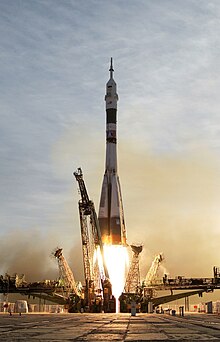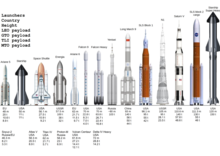
Back صاروخ حامل Arabic Llanzadera espacial AST Daşıyıcı raket Azerbaijani Ракета-носьбіт Byelorussian Ракета-носьбіт BE-X-OLD Ракета носител Bulgarian উৎক্ষেপক যান Bengali/Bangla Vehicle de llançament Catalan مووشەک ھەڵگر CKB Nosná raketa Czech
This article needs additional citations for verification. (August 2009) |
| Part of a series on |
| Spaceflight |
|---|
 |
|
|


A launch vehicle is typically a rocket-powered vehicle designed to carry a payload (a crewed spacecraft or satellites) from Earth's surface or lower atmosphere to outer space. The most common form is the ballistic missile-shaped multistage rocket, but the term is more general and also encompasses vehicles like the Space Shuttle. Most launch vehicles operate from a launch pad, supported by a launch control center and systems such as vehicle assembly and fueling.[1] Launch vehicles are engineered with advanced aerodynamics and technologies, which contribute to high operating costs.
An orbital launch vehicle must lift its payload at least to the boundary of space, approximately 150 km (93 mi) and accelerate it to a horizontal velocity of at least 7,814 m/s (17,480 mph).[2] Suborbital vehicles launch their payloads to lower velocity or are launched at elevation angles greater than horizontal.
Practical orbital launch vehicles use chemical propellants such as solid fuel, liquid hydrogen, kerosene, liquid oxygen, or hypergolic propellants.
Launch vehicles are classified by their orbital payload capacity, ranging from small-, medium-, heavy- to super-heavy lift.
- ^ "NASA Kills 'Wounded' Launch System Upgrade at KSC". Florida Today. Archived from the original on 2002-10-13.
- ^ Hill, James V. H. (April 1999), "Getting to Low Earth Orbit", Space Future, archived from the original on 2012-03-19, retrieved 2012-03-18.